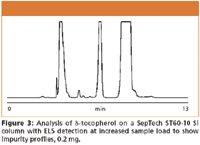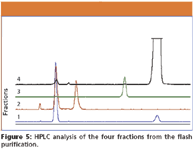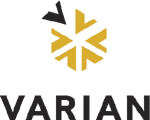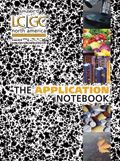Flash Purification of δ-Tocopherol and Subsequent HPLC Analysis for Sample Purity
Following the recent surge in popularity of flash chromatography as a rapid purification technique, two options now exist for small-to-large-scale purifications of crude samples.
L. Lloyd, S. Ball, and K. Mapp, Varian, Inc.
Following the recent surge in popularity of flash chromatography as a rapid purification technique, two options now exist for small-to-large-scale purifications of crude samples. HPLC is a high performance method using small particle media, which is suited to the purification of complex samples where high purity is required. Flash is a low-pressure technique using larger particle media and is suited to less complex samples or where lower purities are acceptable.
Analytical HPLC system was used for method development of a normal phase purification of δ-tocopherol. Flash chromatography was chosen as the purification technique, followed by subsequent screening of the collected fractions by HPLC to assess sample purity.
Tocopherols are a series of organic compounds consisting of various methylated phenols. They occur in alpha, beta, gamma, and delta forms, determined by the number of methyl groups on the chromanol ring. Due to their limited UV absorption, tocopherols require an alternative to UV detection — ELSD.
The Varian 971-FP instrument utilizes an evaporative light scattering detector (ELSD) as an additional method of detection. Data are shown to demonstrate how a separation developed on a standard HPLC system can be scaled up for purification on the 971-FP flash instrument.
Methods and Materials
Sample Preparation
For method development, a solution containing 0.2 mg/mL of δ-tocopherol in heptane was used. Further 2 mg/mL and 10 mg/mL concentrations were also required for the purification stages.
Analytical HPLC
An analytical HPLC system consisting of a single isocratic pump, 7725i Rheodyne® valve (with 200 μL sample loop) and Varian 385-LC ELS detector was used. The operating conditions were as follows:
Instrument: Isocratic HPLC with 385-LC ELSD
Column: SepTech™ ST60-10 Si, 10 μm 250 × 4.6 mm
(pn: A8061250X046)
Sample Conc: 10 μL of 0.2 mg/mL solution of δ-tocopherol
Eluent: 90:10 heptane:ethyl acetate
Flow Rate: 1 mL/min
Flash Purification
Instrument: 971-FP with 385-LC ELSD
Column: SF15-12g Si 35 (pn: AX1371)
Sample Conc: 1000 μL of 10 mg/mL solution of δ-tocopherol
Eluent: 90:10 heptane/ethyl acetate
Flow Rate: 6 mL/min
Fraction Analysis
The fractions collected from the δ-tocopherol purification were analyzed by HPLC using the SepTech ST60-10 Si column.

Figure 1
Results
Figure 2 shows the chromatogram obtained from a 10 μL injection of a 0.2 mg/mL solution of δ-tocopherol onto the SepTech ST60-10 Silica HPLC column. This gave an analytical loading of 0.002 mg on-column.

Figure 2
A second injection, 100 μL of a 2 mg/mL solution, was made to demonstrate a preparative load (× 100) on the same column (Figure 3). This revealed some additional impurities in the sample that were not previously apparent.

Figure 3
The flash purification was done on the 971-FP flash instrument, was done on by direct injection of the δ-tocopherol. Figure 4 shows the resulting chromatogram.

Figure 4
During the flash purification run, four fractions were collected (as highlighted by the colored bands in Figure 4). 50 μL of each fraction were analyzed using the HPLC analytical method. Figure 5 shows an overlay of their HPLC profiles.

Figure 5
Table I summarizes the fraction qualities and shows δ-tocopherol was isolated with 100% purity.

Table I: Composition of purification fractions
Conclusion
The results demonstrate that chromatographic separations can be transferred between HPLC and flash systems, saving both time and money.
A Varian 385-LC ELS detector can be used in combination with both techniques to give increased sensitivity for method development and fraction analysis.

Table I: Composition of purification fractions Varian, Inc.
3120 Hansen Way, Palo Alto, CA 94304
tel. (800)926-3000, (925)939-2400
Website: www.varianinc.com

A Guide To Finding the Ideal Syringe and Needle
January 20th 2025Hamilton has produced a series of reference guides to assist science professionals in finding the best-suited products and configurations for their applications. The Syringe and Needle Reference Guide provides detailed information on Hamilton Company’s full portfolio of syringes and needles. Everything from cleaning and preventative maintenance to individual part numbers are available for review. It also includes selection charts to help you choose between syringe terminations like cemented needles and luer tips.
Oasis or Sand Dune? Isolation of Psychedelic Compounds
January 20th 2025Magic mushrooms, once taboo, have recently experienced a renaissance. This new awakening is partially due to new findings that indicate the effects of psilocybin, and its dephosphorylated cousin psilocin may produce long lasting results for patients who might be struggling with anxiety, depression, alcohol and drug abuse, and post-traumatic stress disorder. Hamilton Company has developed a methodology for the isolation and identification of 5 common psychedelic compounds used in the potential treatment of disease. The PRP-1 HPLC column resin remains stable in the harsh alkaline conditions ideal for better separations.
GPCRs – The Biological Traffic Modulator: Chromatographic Analysis of Peptides in the GI Tract
January 20th 2025The G protein-coupled receptors (GPCR) are found throughout the entire body and have shown significance in the development of new therapeutic treatments. Isolation of seven classic GRPC peptides initiating in the GI tract highlights the benefits of using the polymer-based PRP-3, a reversed-phase resin. The covalent bonds found in the PRP-3 exhibit advantageous interactions between the biological π bonds found in the peptides and the available aromatic benzyl rings of the resin.